We continue our dive into mushrooms with one that most people will be familiar with: the shiitake mushroom! This mushroom is very popular in cooking and most often appears in dishes from a lot of Asian countries. But there are many more benefits to this fungi than just its taste. Today, we go into the history and uses of the shitake and what makes it a great addition to your cancer-fighting protocol. Let’s get started!
*Note: Please keep in mind that I am not a doctor and you should not take the following information as a replacement for advice from a licenced professional. Always consult with a member of your healthcare team before starting any new supplements or natural compounds. The following information has not been evaluated by the FDA.
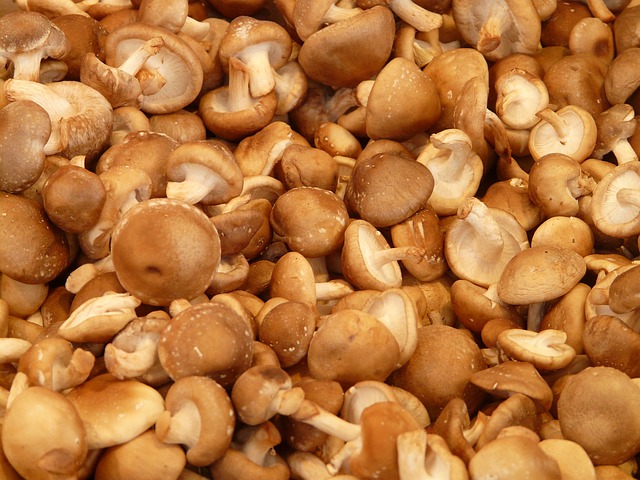
The Shiitake Story
Also called Lentinula edodes and Xianggu, the shiitake mushroom is one ancient organism. It has been estimated that its origin can be traced back to over one hundred million years ago! In the wild, they grow on felled logs of various trees including oak, sugar maple, hophornbeam, ironwood, alder, poplars, and yellow birch [1]. They grow in the mountains of China, Japan, Indonesia and Taiwan [2], so unfortunately you won’t stumble upon this one on your weekend hike unless you are in Asia. But you can grow them in North America for cultivation by inoculating logs with their spores. This is quite a process though, so if you are interested, I suggest doing some reading first; this is a great place to start.
You will find many variations of these little guys, but generally they have a medium-sized cap that varies from tan to brown. Those with large, cracked tops are the most sought after and expensive for their meaty texture [2]. When it comes to their taste, shiitake mushrooms are definitely the best of the medicinal bunch, prized in the culinary world for a taste that is described as a “[…] rich, buttery, meaty flavor quite unlike the flavors of other mushroom varieties. When dried, the shiitake’s flavors concentrate to a smoky richness” [3]. This is one tasty mushroom that you won’t mind adding to your diet!
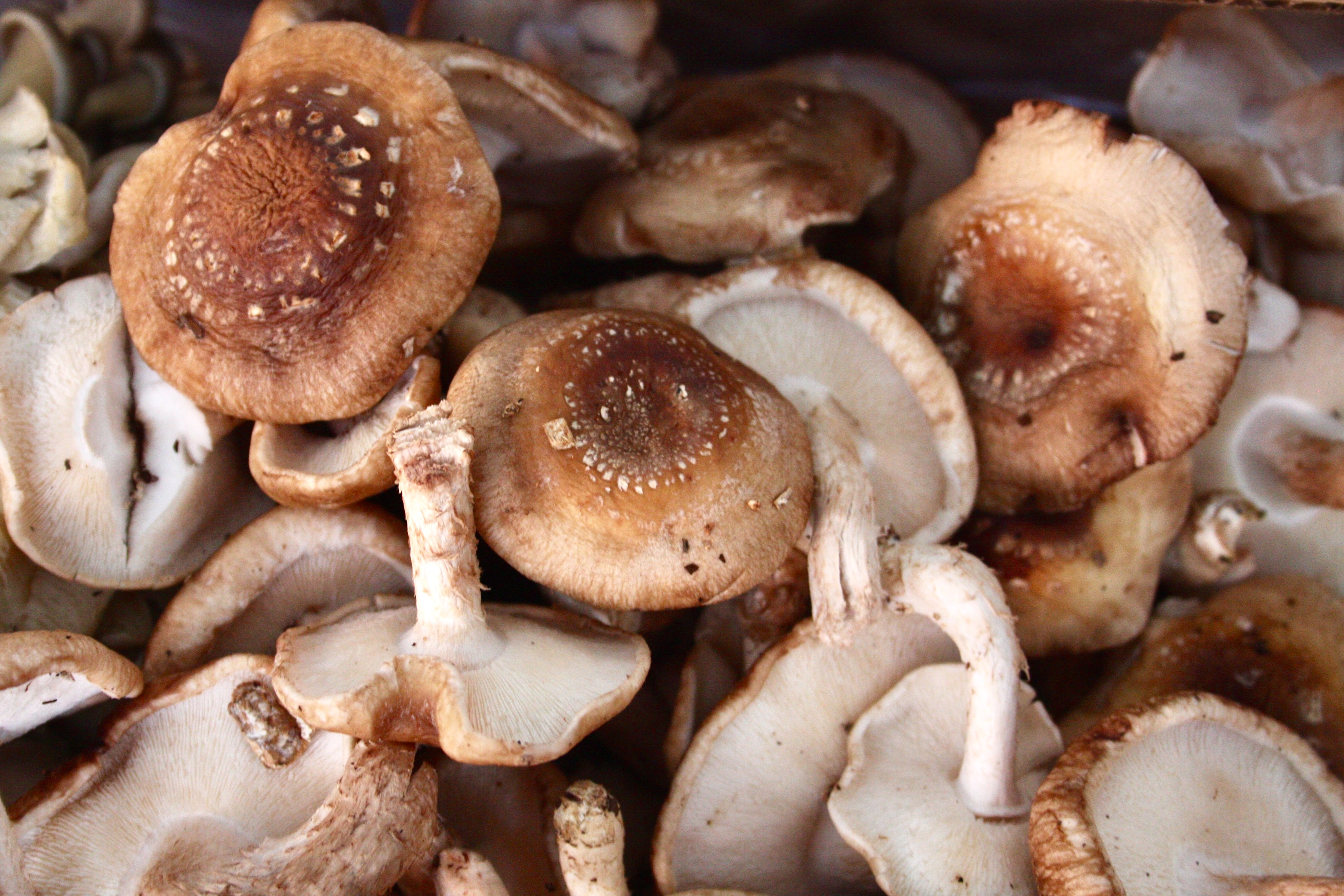
What’s their deal?
This mushroom has been grown as a crop for its delicious taste and its purported health benefits for at least 2000 years [1]. It is suggested that they may reduce cholesterol, enhance sexual power, prolong life, and improve circulation [2], though not all of these have been tested. Studies do show however that shiitake mushrooms have tremendous potential for oral health and as an antioxidant, anticancer, antigingivitis, antifungal, and antiviral agent [4].
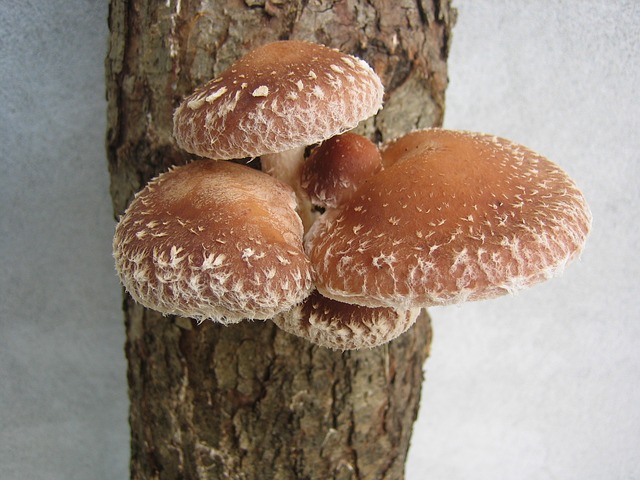
Cancer Crusader
The active compound in shiitake mushrooms that is most heavily studied for its use against cancer is a glucan (a polysaccharide/carbohydrate) called Lentinan. There are a number of benefits of Lentinan that have been studied.
Enhancing the Immune System
Lentinan’s immune-stimulating properties have been known for a long time. First, a brief overview of some important parts of the immune system. Macrophages are white blood cells that detect and destroy threats to your body and also release molecules called cytokines that activate other cells [5]. Dendritic Cells are like the sentinels of your immune system and are responsible for the initiation of an immune response [6], making them quite important to your immune system! These next two are some of the most important components when it comes to cancer. Cytotoxic T cells kill tumours and virally infected cells [7], while Natural Killer cells play a vital role in the detection and control of early sign of cancer [8]. Finally, Th1 and Th2 cells are subsets of the T cell category, and they are also responsible for activating an immune response. Th1 cells promote immunity by initiating a cytotoxic response (one that is toxic to cells) and are considered to be our main anticancer mechanism [9]. On the other hand, Th2 cells are involved principally against pathogens like bacteria and parasites [9]. Here’s the problem: when one response is activated (either Th1 or Th2), the other response is inhibited, meaning that if your Th2 response is initiated, your anticancer Th1 response will be stopped [9], which we obviously want to limit.
So, where do shiitake mushrooms fit into all of this? The immune modulating effects of the glucan Lentinan are many. They include macrophage activation, Dendritic Cell activation, an increase of cytotoxic T cells and Natural Killer activity, and enhancement of Th1 vs Th2 response [10]. All of the components of your immune system described above that play important roles in the body’s fight against cancer are supported and increased by Lentinan!
Anti-tumour Effects
Shiitake mushrooms have a number of tumoricidal effects thanks again to the glucan Lentinan. These include inducing apoptosis (programmed cell death), tumour suppression, and cell cycle arrest (stopping cancer cells’ uncontrolled replication cycle) [10]. If that’s enough info for you, you can skip to the next section, but if you are curious about the science behind how it achieves these effects, read on!
Lentinan induces apoptosis in a few ways. Firstly, it decreases the expression of TERT (telomerase reverse transcriptase) in a cell, which is an enzyme that lengthens a cell’s DNA and ultimately prevents it from dying [10, 11]. Additionally, it enhances the proteins BAX and CASP3/9, which in turn both promote apoptosis, and it decreases the activity of the protein BCL2, which is a protein that inhibits apoptosis [10].
Lentinan achieves tumour suppression through its action on the MYC and TP53 genes. It decreases the expression of the MYC gene, which is responsible for cell growth [10, 12]. TP53 is a gene that suppresses tumour growth and it is the most commonly mutated gene found in cancer cells [13]. When this gene is mutated and not expressing, it cannot do its job in suppressing the growth of tumour cells. Lentinan acts on this gene and enhances its expression, thereby increasing the tumour suppressing activity of TP53 [10].
Finally, Lentinan reduces cell proliferation by encouraging cell cycle arrest. It promotes the protein p21 [10], which in turn inhibits a group of enzymes that play an important role in DNA replication. This ultimately means that DNA replication is halted and therefore cell growth is as well [14].
Countering the Side Effects of Conventional Treatment
Many studies have found that Lentinan works very well with chemo to achieve a number of positive effects. It synergistically increases the performance of chemo while reducing its side effects, allowing for prolonged and better tolerated treatment [10]. Studies have also found that the administration of Lentinan along with chemo agents results in longer survival rates and better quality of life [10]. Lentinan definitely shows promise as a complementary addition to conventional treatments.
Antioxidative Effects
Lentinan is a highly effective antioxidant, helping to prevent oxidative damage while also aiding in the repair of any damage already done. One study done with human skin cells demonstrated that Lentinan has the ability to enhance a cell’s capacity to tolerate oxidative damage, increase cells’ stress resistance, and protect and repair damaged cells [15]. That’s one powerful glucan!
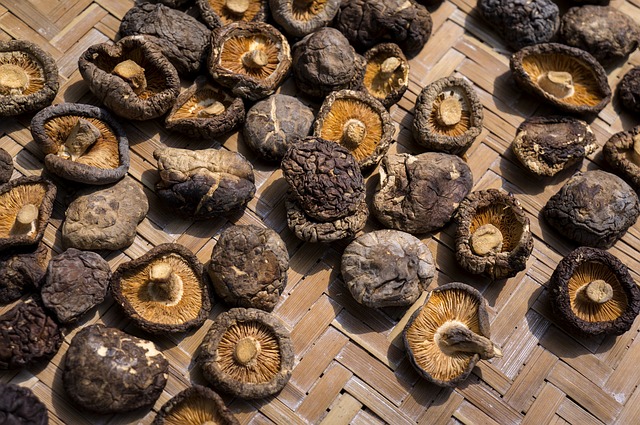
These fungi sound fantastic! But what do I even do with them?
*These recommendations are similar to those in Part 1 of this series and will continue to be so for the remainder of the series as well, with the exception of a few additions from mushroom to mushroom. I will always put the new additions at the top, so feel free to read just the new one(s) or the full list if you want a review or haven’t read the other posts in this series 🙂
There are a few different ways to use shiitake mushrooms. Some are easier to incorporate than others while some methods result in easier absorption. When it comes down to it though, you want to pick the method which will be the easiest for you to maintain; from my experience, no matter how good something is for you, if it is a hassle to do and not relatively easy to fit into your routine, eventually you will drop it.
In cooking
Because these mushrooms taste so good, the most delicious way to incorporate them into your protocol is by cooking with them. Try them in soups, stews, omelettes, stir fries, and more! If it calls for mushrooms, you can use shiitakes.
Capsules
If you don’t like mushrooms as a food, capsules are the next-easiest method for adding them to your protocol. For shiitake, the usual dose can range from 3 to 6 capsules a day. This method is super easy to work into your routine, as many of us are already taking supplements and it doesn’t take much to add one more. The issue with capsules is that they can be difficult for your body to absorb, so if you know that you have trouble making proper use of supplements, you may be better off choosing one of the following options.
Powder in smoothies or broth
If you already have smoothies in your diet, a great way to get your shiitake in is to buy it in powder form and add a teaspoon to your smoothie. Unlike some of the other mushrooms I will be talking about later, shiitake is quite good when it comes to taste, so you likely won’t notice its addition.
Although this is a convenient option for those making smoothies anyway and a fine choice if it is the easiest for you to maintain, smoothies do tend to be cold and mushrooms are better absorbed when they are warm. “[…] medicinal mushrooms have low bioavailability unless they undergo a hot water extraction process. Meaning, we are not able to absorb mushrooms’ nutrients because the fungi lock their immune activating beta-glucans and polysaccharides in chitin cell walls, which are indigestible to humans” [16]. So, make sure your capsules and powders were hot-water extracted by the manufacturer, and then it is best to take them using something warm. A way to do this is to whisk a teaspoon of shiitake powder into some bone broth or soup. The mushroomy flavour goes well with the savory broth, and the heat makes it easier for your body to absorb.
There is much controversy over soy as a phytoestrogen for those who have/had hormone driven cancers, but most experts agree that the less processed and fermented forms are fine to include in your diet in moderation. Miso soup then is a tasty base to which to add your shiitake powder, and you are also getting a fermented food into your diet which your gut buddies will love.
And if you are into cooking, I love this mushroom broth recipe from Handmade Apothecary. It’s great on its own or you can use it as a base for soups, stews, gravy, curries and more! I love this one because it makes it easier to work mushrooms into your regular diet. Anytime a recipe calls for stock, you can use this broth. This recipe uses turkey tail and chaga mushrooms, but you can either swap out the turkey tail for shiitake or you can use all three!
Tea with powder or by boiling mushroom pieces
If soup isn’t your thing, another way to use heat to up the absorption factor is by making shiitake tea. You can make a tea quite easily by boiling pieces of the dried or fresh fungi. Simply add about 1 tablespoon of mushroom pieces for dried and 2 tablespoons for fresh to 2 cups of boiling water, boil for 20-30 minutes, strain and enjoy. Leftover tea can be stored in the fridge for 3-4 days.
It would be unlikely, but if you can’t find dried or fresh shiitake for some reason or if you already have powder, you can also whisk a teaspoon of powder into a cup of boiling water, add some lemon or a peppermint tea bag, and enjoy! As I said above, shiitake is quite tasty, so you will probably be okay with this tea as is. If, however, you find the taste too strong, try adding a little honey or waiting for it to cool and calling on your early twenties to treat it like a shot and just down it!
Ready-made products
If the homemade smoothie, soup or tea options aren’t for you, there are lots of ready-made mushroom products on the market that make including them in your diet more palatable. My favourite company by far is Four Sigmatic for the quality and variety of their products. Plus, they are such nice people!
Whether you get them from Four Sigmatic or not, some of the types of products you can expect to find include
- Coffees
- Teas
- Chocolates
- Protein Powders
- Elixirs
Play around with all of these options and see which works best for you. I personally take my shiitake as a powder because I have a big bag of it to use up. Whenever I have a bowl of soup (which is quite often) I whisk in a teaspoon of shiitake powder. It is a convenient way to incorporate it because I’m having soup anyway and it also boosts the flavour!
Remember, consistency is key. Even if it isn’t all absorbed, some mushroom every day is better than not having any at all, so try them out and see which method fits most comfortably into your routine. And if you find another way to include shiitake in your diet, a tasty recipe or a more convenient method, please feel free to share it in the Facebook group or let me know via the “Contact Me” page here.
Happy Healing ❤️
References
- Growing Shiitake Mushrooms: Step-by-Step Guide to an Agroforestry Crop – https://northernwoodlands.org/articles/article/growing_shiitake_mushrooms
- Shiitake – https://www.mssf.org/cookbook/shiitake.html
- Shiitake Mushrooms – https://www.finecooking.com/ingredient/shiitake-mushrooms
- The Unexplored Anticaries Potential of Shiitake Mushroom – https://www.ncbi.nlm.nih.gov/pubmed/28082791
- Macrophages – https://www.immunology.org/public-information/bitesized-immunology/c%C3%A9lulas/macrophages
- Dendritic Cells – https://www.immunology.org/public-information/bitesized-immunology/cells/dendritic-cells
- Helper and Cytotoxic T Cells – https://www.immunology.org/public-information/bitesized-immunology/c%C3%A9lulas/helper-and-cytotoxic-t-cells
- Natural Killer Cells – https://www.immunology.org/public-information/bitesized-immunology/c%C3%A9lulas/natural-killer-cells
- Alterations in the Th1/Th2 balance in breast cancer patients using reflexology and scalp massage – https://www.ncbi.nlm.nih.gov/pmc/articles/PMC3490382/
- Lentinan Properties in Anticancer Therapy: A Review on the Last 12-Year Literature – https://pdfs.semanticscholar.org/a8e7/a6f89ca953c32bd089b26893f71cee0290ba.pdf
- Telomerase reverse transcriptase – https://en.wikipedia.org/wiki/Telomerase_reverse_transcriptase
- MYC – https://en.wikipedia.org/wiki/Myc
- p53 – https://en.wikipedia.org/wiki/P53
- Encyclopedia of Cancer: p21 – https://link.springer.com/referenceworkentry/10.1007%2F978-3-642-16483-5_4327
- Antioxidant action and protective and reparative effects of lentinan on oxidative damage in HaCaT cells. – https://www.ncbi.nlm.nih.gov/pubmed/29473282
- Why People are Shrooming Out on Medicinal Mushroom Tea – https://www.eater.com/2015/3/11/8181107/why-people-are-shrooming-out-on-medicinal-mushroom-tea

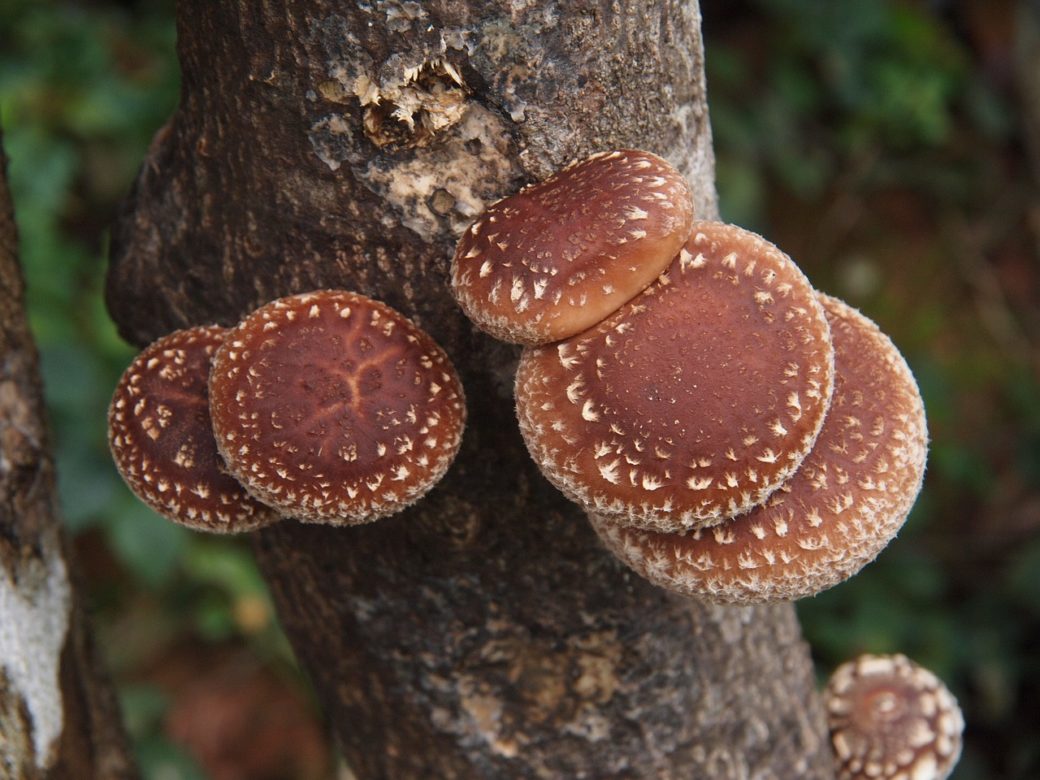


0 Comments